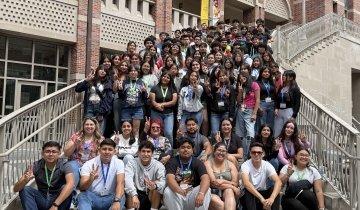Racial disparities on measurable indicators of student achievement in K-12 schools are tiny, practically nonexistent. Schools no longer serve as pipelines to prisons, as there is no racial disproportionality in suspensions and expulsions, metal detectors that foster cultures of imprisonment have been removed, and uniformed officers and other school personnel have discontinued profiling students because of their race.
Compared to prior decades, the racial composition of the teacher workforce more closely matches demographics of students in their classrooms. Although White professionals still comprise the majority, they teach in ways that meaningfully honor a wide array of cultural histories. They sustain classrooms in which students of color are affirmed, valued, extraordinarily engaged and academically high performing.
White educators also interact and partner with families of color in respectful, supportive ways. Teacher education programs effectively prepare them and educators of color for this. Similarly, credential, certification and EdD programs prepare principals, superintendents and other administrators to lead equitable and inclusive schools and districts. There are very few racial problems in schools. But when they arise, educators talk honestly about them, instead of talking around them. They engage racial issues without becoming defensive, minimizing their realness and severity, or expecting their colleagues of color to solve them.
In higher education, racial inequities in access, persistence, academic performance, graduation rates and other metrics of student success require so little attention because they are so insignificant and uncommon. Students, employees and visitors consistently experience campuses as inclusive; hardly anyone ever deems campus environments racist. Students of color and their White classmates deeply engage a wide range of racial viewpoints in the curriculum, not just Eurocentric content. They benefit educationally from the wide array of cultural perspectives each of them brings to college; they learn how to talk to each other, despite and because of their racial differences; and they are fully prepared for citizenship in a racially diverse democracy after college.
Students learn how to analyze, talk about and strategically disrupt racial inequities that await them in their post-college careers. No student has just one Latinx, Pacific Islander, Black, Native American, multiracial or Asian American professor. In fact, most have so many that they easily lose count. Racial stratification is no longer an indefensible, ordinary feature of the postsecondary workplace. Large numbers of people of color work not only in food service, landscaping, custodial and secretarial roles; they also comprise significant shares of employees in positions located at the power epicenter: presidents, provosts and other vice presidents, deans, department chairs, and tenured faculty members. Any postsecondary institution that looks, functions and behaves differently than this is an outlier that is ridiculed by the rest of higher education.
This vision of K-12 schools and districts, colleges and universities inspires USC Race and Equity Center colleagues and me. It motivates our work. We know that a more racially just future is realizable for educational institutions and systems. But we also know that our nation will never achieve racial equity without changing what and how educators, leaders and policymakers are taught. Improving their racial literacy, undoing ways they have been socialized to avoid difficult conversations about race and teaching them how to manufacture racial equity through personal acts, policies and practices are absolute musts. Helping them first recognize and then discard deficit, criminalized, hopeless and racist frames concerning students of color and their families also are required. They need corrective strategies and tools. Additionally, accountability, disaggregated data and rigorous racialized assessments, and serious professional consequences are definite musts. At the USC Race and Equity Center, we aim to help our country actualize this vision of educational equity.





